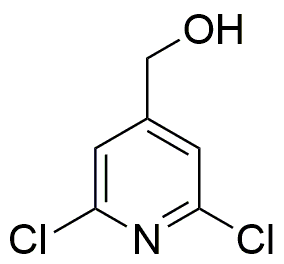2,6-Dichloro-4-pyridinemethanol is widely utilized in research focused on:
- Pharmaceutical Development: This compound serves as an important intermediate in the synthesis of various pharmaceuticals, particularly those targeting neurological disorders, due to its ability to interact with specific receptors in the brain.
- Agricultural Chemicals: It is used in the formulation of herbicides and pesticides, providing effective control over unwanted plant growth while minimizing harm to beneficial organisms.
- Analytical Chemistry: The compound is employed as a reagent in analytical methods, aiding in the detection and quantification of other substances in complex mixtures, which is crucial for quality control in manufacturing.
- Material Science: It is incorporated into the development of specialized coatings and polymers, enhancing properties like durability and resistance to environmental factors.
- Biochemical Research: Researchers utilize this compound in studies related to enzyme inhibition and metabolic pathways, providing insights into cellular processes and potential therapeutic targets.
Información general
Propiedades
Seguridad y normativas
Aplicaciones
2,6-Dichloro-4-pyridinemethanol is widely utilized in research focused on:
- Pharmaceutical Development: This compound serves as an important intermediate in the synthesis of various pharmaceuticals, particularly those targeting neurological disorders, due to its ability to interact with specific receptors in the brain.
- Agricultural Chemicals: It is used in the formulation of herbicides and pesticides, providing effective control over unwanted plant growth while minimizing harm to beneficial organisms.
- Analytical Chemistry: The compound is employed as a reagent in analytical methods, aiding in the detection and quantification of other substances in complex mixtures, which is crucial for quality control in manufacturing.
- Material Science: It is incorporated into the development of specialized coatings and polymers, enhancing properties like durability and resistance to environmental factors.
- Biochemical Research: Researchers utilize this compound in studies related to enzyme inhibition and metabolic pathways, providing insights into cellular processes and potential therapeutic targets.
Documentos
Hojas de datos de seguridad (HDS)
La SDS proporciona información de seguridad completa sobre la manipulación, el almacenamiento y la eliminación del producto.
Especificación del producto (PS)
La PS proporciona un desglose completo de las propiedades del producto, incluida la composición química, el estado físico, la pureza y los requisitos de almacenamiento. También detalla los rangos de calidad aceptables y las aplicaciones previstas del producto.
Certificados de análisis (COA)
Busque certificados de análisis (COA) ingresando el número de lote del producto. Los números de lote y de partida se pueden encontrar en la etiqueta de un producto después de las palabras "Lote" o "Lote".
Número de catálogo
Número de lote/lote
Certificados de origen (COO)
Este certificado de origen confirma el país en el que se fabricó el producto y también detalla los materiales y componentes utilizados en él y si se deriva de fuentes naturales, sintéticas u otras fuentes específicas. Este certificado puede ser necesario para cumplir con las normativas aduaneras, comerciales y regulatorias.
Número de catálogo
Número de lote/lote
Hojas de datos de seguridad (HDS)
La SDS proporciona información de seguridad completa sobre la manipulación, el almacenamiento y la eliminación del producto.
DownloadEspecificación del producto (PS)
La PS proporciona un desglose completo de las propiedades del producto, incluida la composición química, el estado físico, la pureza y los requisitos de almacenamiento. También detalla los rangos de calidad aceptables y las aplicaciones previstas del producto.
DownloadCertificados de análisis (COA)
Busque certificados de análisis (COA) ingresando el número de lote del producto. Los números de lote y de partida se pueden encontrar en la etiqueta de un producto después de las palabras "Lote" o "Lote".
Número de catálogo
Número de lote/lote
Certificados de origen (COO)
Este certificado de origen confirma el país en el que se fabricó el producto y también detalla los materiales y componentes utilizados en él y si se deriva de fuentes naturales, sintéticas u otras fuentes específicas. Este certificado puede ser necesario para cumplir con las normativas aduaneras, comerciales y regulatorias.


